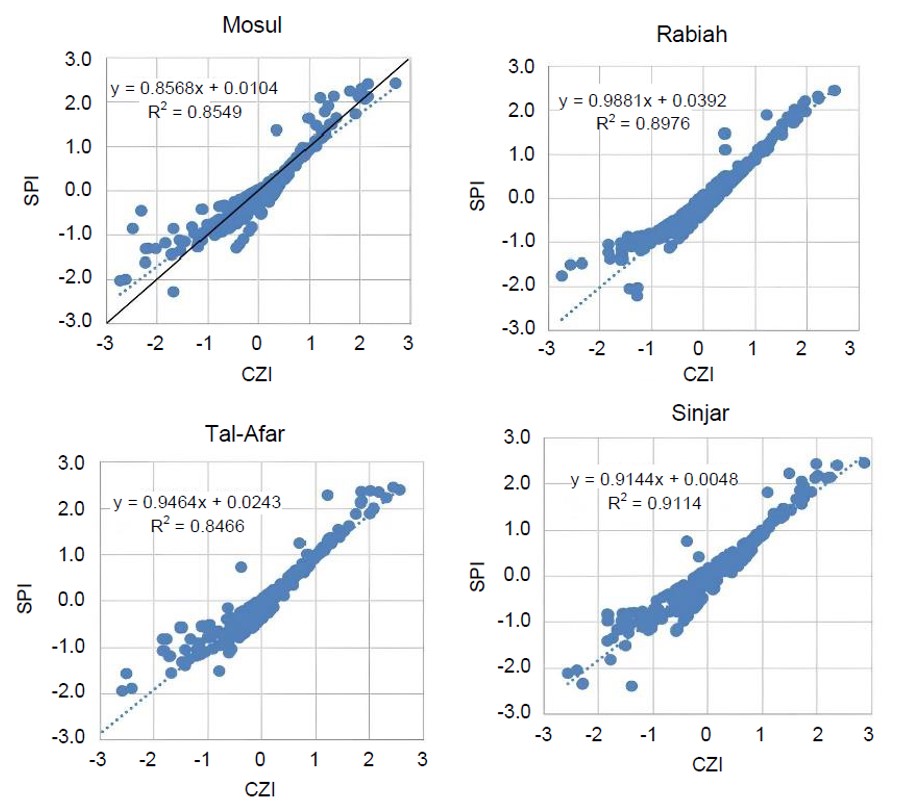Climate change and the behaviour of meteorological drought and its impact on wheat yield
Main Article Content
Abstract
Climate change is the most prominent issue in this decade. The expected impacts of this change have become a reality, with rising sea levels and long, intense heat waves occurring globally. The present study examines the characteristics of drought in Nineveh Governorate and its impact on the wheat crop. Two drought indices were used in the study: (1) the Standardised Precipitation Index (SPI) and (2) the Chinese Z Index (CZI). The study used climate data on rainfall and temperature for the period 1990–2020 from eight meteorological stations distributed in the study area. Results showed a nonsignificant decrease in rainfall and an increase in maximum and minimum temperatures. Results also showed that the highest recurrence rates of drought (recorded at the Tal-Abta) are 51.2% and 56% for SPI and CZI, whereas the lowest rates (recorded at Mosul, Sheikhan and Sinjar) are 45.1% and 50.8% for SPI and CZI, respectively. The two drought indices match in identifying wet and dry periods, with R2 values ranging from 0.84 to 0.94. Furthermore, a relationship was found between productivity and climatic drought indices and it was concluded that wheat productivity is more significantly influenced by the distribution of rainfall than by drought. The current study can help demonstrate the extent of climate change’s impacts on wheat productivity. Thus, the results can contribute to planning and managing agricultural production according to climate change.
Article Details

This work is licensed under a Creative Commons Attribution-NonCommercial-NoDerivatives 4.0 International License.
This work is licensed under a Creative Commons Attribution-NonCommercial-NoDerivatives 4.0 International License.
References
Glauben T, Svanidze M, Götz L, Prehn S, Jaghdani TJ, Đurić I, et al. The war in Ukraine, agricultural trade and risks to global food security. Intereconomics. 2022;57(3):157-63.
Budak H, Kantar M, Kurtoglu KY. Drought tolerance in modern and wild wheat. Sci World J. 2013;2013:548246.
El-Tantawi AM, Bao A, Liu Y, Gamal G. Assessment of meteorological drought in north-western egypt using rainfall deciles, standardized precipitation index and reconnaissance drought index. Disaster Adv. 2021;14(1):1-14.
Zarch MAA, Sivakumar B, Sharma A. Droughts in a warming climate: a global assessment of Standardized precipitation index (SPI) and Reconnaissance drought index (RDI). J Hydrol. 2015;526:183-95.
Office for the Coordination of Humanitarian Affairs. Water crisis and drought threaten more than 12 million in Syria and Iraq. Reliefweb [Internet]. 2021 Aug 23 [cited 2023 Nov 2]. Available from: https://reliefweb.int/report/syrian-arab-republic/water-crisis-and-drought-threaten-more-12-million-syria-and-iraq?gad_source=1&gclid=CjwKCAiA3JCvBhA8EiwA4kujZgFo833X ThVMU_CrN8SZfLmmqmEn22Mlpk9dlO18bQq517IJh6N4DxoCvysQAvD_BwE.
Zampieri M, Toreti A, Ceglar A, Naumann G, Turco M, Tebaldi C. Climate resilience of the top ten wheat producers in the Mediterranean and the Middle East. Reg Environ Change. 2020;20:41.
Mahmood Agha OMA, Şarlak N. Spatial and temporal patterns of climate variables in Iraq. Arab J Geosci. 2016;9:302.
Shahabfar A, Eitzinger J. Spatio-Temporal analysis of droughts in semi-arid regions by using meteorological drought indices. Atmosphere. 2013;4(2):94-112.
Hasan IF. Trend detection of metrological drought in North of Iraq. J Eng Sustain Dev. 2021;25(3):60-73.
Zou Y, Zhu L, He Y, Lin Y, Liang X, Ye C. Comparative study on appropriate drought and flood index selection in a tropical farming island in China. Front Earth Sci. 2023;10:1-13.
Leng G, Hall J. Crop yield sensitivity of global major agricultural countries to droughts and the projected changes in the future. Sci Total Environ. 2019;654:811-21.
Karatayev M, Clarke M, Salnikov V, Bekseitova R, Nizamova M. Monitoring climate change, drought conditions and wheat production in Eurasia: the case study of Kazakhstan. Heliyon. 2022;8(1):e08660.
Al-Bazaz HJ, Mahmood Agha OMA. A study of the homogeneity of climatic data for rain, temperature and humidity for Nineveh Governorate. Al-Rafidain Eng J. 2023;28(2):173-85.
World Meteorological Organization. Guide to climatological practices. WMO-No.100. Geneva: WMO; 2018.
Mann HB. Nonparametric tests against trend. Econometrica. 1945;13(3):245-59.
Kendall MG. Rank correlation methods. 4th ed. London: Griffin; 1975.
Sen PK. Estimates of the regression coefficient based on Kendall's Tau. J Am Stat Assoc. 1968;63(324):1379-89.
Mckee TB, Doesken NJ, Kleist J. The relationship of drought frequency and duration to time scales. Eighth Conference on Applied Climatology; 1993 Jan 17-22; Anaheim, Canada. p. 1-6.
Wu H, Hayes MJ, Weiss A, Hu Q. An evaluation of the standardized precipitation index, the China-Z Index and the statistical Z-Score. Int J Climatol. 2001;21(6):745-58.
Mahmood Agha OMA. Investigating the meteorological drought Using CZI in Nineveh Governorate, Iraq. Tikrit J Eng Scis. 2021;28(4):14- 24.
Adary A, Hachum A, Oweis T, Pala M. Wheat productivity under supplemental irrigation in Northern Iraq. On-Farm water husbandry research report series, No. 2. Lebanon: International Center for Agricultural Research in the Dry Areas (ICARDA); 2002.
Allen RG, Pereira LS, Raes D, Smith M. Crop evapotranspiration - guidelines for computing crop water requirements - FAO Irrigation and drainage paper 56. Rome: FAO; 1998.
Oweis T, Hachum A. Reducing peak supplemental irrigation demand by extending sowing dates. Agric Water Manag. 2001;50(2):109-23.
Jajo NM, Hazem E, Hameed RM. Maximizing the benefit from rain and supplemental irrigation water in Mosul area. Al-Rafidain Eng J. 2011;19(4):78-88.
Doorenbos J, Kassam AH. Yield response to water. FAO Irrigation and Drainage, Paper 33. Rome: FAO; 1979.
Hayes M, Svoboda W, Wall N, Widhalm M. The Lincoln declaration on drought indices: universal meteorological drought index. Bull Am Meterol Soc. 2011;92(4):485-8.
Morid S, Smakhtin V, Moghaddasi M. Comparison of seven meteorological indices for drought monitoring in Iran. Int J Climatol. 2006;26(7):971-85.
Patil R, Polisgowdar BS, Rathod S, Kumar U, Wali V, Srinivasa Reddy GV, et al. Comparison and evaluation of drought indices using analytical hierarchy process (AHP) over Raichur district, Karnataka. MAUSAM. 2023;74(1):43-56.



